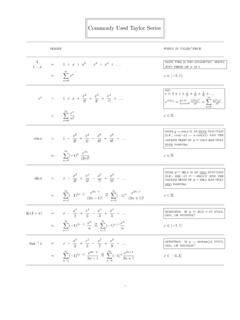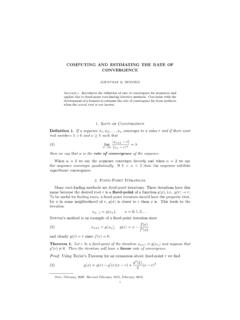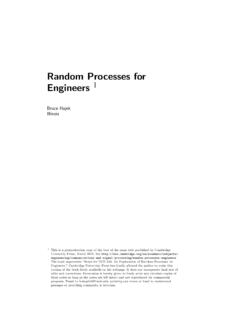Taylor S Theorem
Found 9 free book(s)Introduction to Complex Analysis Michael Taylor
mtaylor.web.unc.edu8. Morera’s theorem, the Schwarz re ection principle, and Goursat’s theorem 9. In nite products 10. Uniqueness and analytic continuation 11. Singularities 12. Laurent series C. Green’s theorem F. The fundamental theorem of algebra (elementary proof) L. Absolutely convergent series Chapter 3. Fourier analysis and complex function theory 13.
Commonly Used Taylor Series - University of South Carolina
people.math.sc.eduTaylor’s Remainder Theorem Version 1: for a xed point x 2I and a xed N 2N. 3 There exists c between x and x 0 so that R N(x) def= f(x) P N(x) theorem= f (N+1)(c) (N + 1)! (x x 0)(N+1): (5) So either x c x 0 or x 0 c x. So we do not know exactly what c is but atleast we know that c is between x and x 0 and so c 2I. Remark: This is a Big ...
Rate of Convergence - Gordon College
math-cs.gordon.eduwhy Newton’s method converges so quickly (when it converges at all). Theorem 2. Let r be a xed-point of the iteration x n+1 = g(x n) and suppose that g0(r) = 0 but g00(r) 6= 0 . Then the iteration will have a quadratic rate of convergence. Proof. Using Taylor’s Theorem once again, but including one more term, we have g(x) = g(r) + g0(r)(x r ...
Random Processes for Engineers 1 - University of Illinois ...
www.ifp.illinois.eduits mean alone. The central limit theorem, similarly tells us a probability distribution can be characterized by its mean and variance. These limit the-orems are analogous to, and in fact examples of, perhaps the most powerful tool ever discovered for dealing with the complexity of functions: Taylor’s
Taylor Series in MATLAB - Texas A&M University
www.math.tamu.eduTaylor Series in MATLAB First, let’s review our two main statements on Taylor polynomials with remainder. Theorem 1. (Taylor polynomial with integral remainder) Suppose a function f(x) and its first n + 1 derivatives are continuous in a closed interval [c,d] containing the point x = a. Then for any value x on this interval
Taylor’s Formula - University of Washington
sites.math.washington.eduTheorem 2 is very useful for calculating Taylor polynomials. It shows that using the formula a k = f(k)(0)=k! is not the only way to calculate P k; rather, if by any means we can nd a polynomial Q of degree k such that f(x) = Q(x)+o(xk), then Q must be P k. Here are two important applications of this fact. Taylor Polynomials of Products. Let Pf ...
The Envelope Theorem - University of Arizona
www.u.arizona.eduHere’s the Envelope Theorem for nvariables and mparamters: The Envelope Theorem: Assume that f : Rn Rm!R is a C1-function, and consider the maximization problem max x2Rn f(x; ). If the solution function x^ : Rm!Rn is di erentiable on an open set U Rm, then the partial derivatives of the value function satisfy @v
1 Taylor’s Series of 1+ x - MIT OpenCourseWare
ocw.mit.eduTaylor’s Series of 1+ x Our next example is the Taylor’s series for 1+ 1 x; this series was first described by Isaac Newton. Remember the formula for the geometric series: 1 − 1 x = 1 + x + x 2 + x 3 + ··· if |x| < 1. If we replace x by −x we get: 1 + 1 x
Chernoff-Hoeffding Inequality
www.cs.utah.eduThey key to this theorem is again the Chernoff-Hoeffding bound. Fix some q2R, and for each point s i in S, let X ibe a random event describing the effect on q(S) of s i. That is X i= 1 if s i2R qand X i= 0 if s i2=R q, so i= 1 for all i2[k]. Let M= P i X i= q(S), and note that E[M] = jSjq(P)=jPj. Multiplying Mby k= jSjwe can now apply Theorem 2 ...








